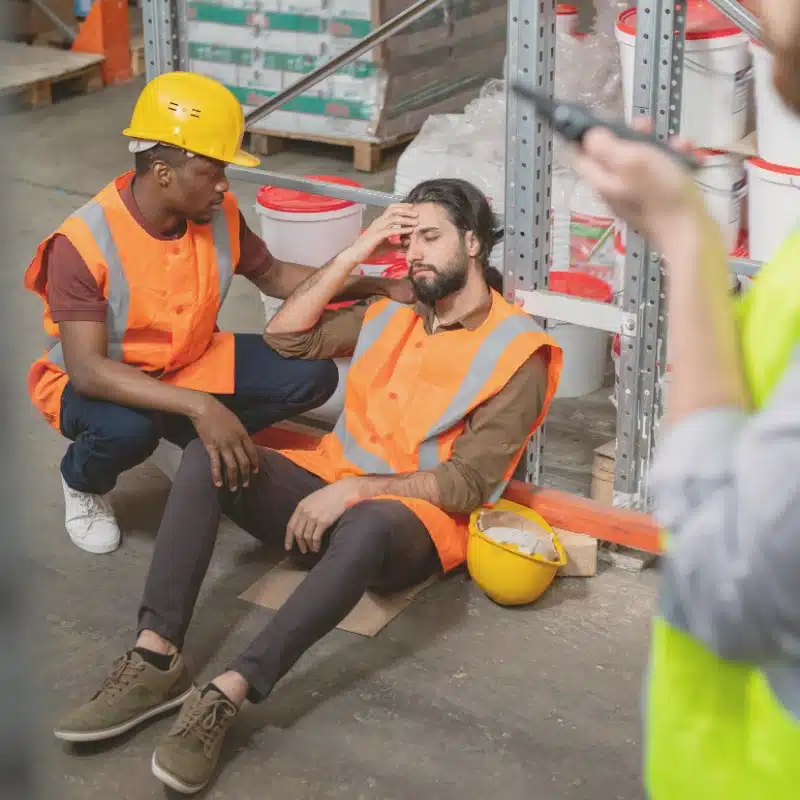Serving injured workers in Douglasville, Columbus, and the surrounding areas of Georgia.
Schedule a ConsultationProtecting Your Interests if You Are Injured at Work
If you are injured at work or suffer from an occupational illness, your employer may seem sympathetic at first. However, the longer your disability lasts, the more your employer and the workers’ compensation carrier may start to view you as an unwanted expense. They may look for ways to stop your benefits, even if you are unable to return to work.
At the Law Office of Ellene Welsh, we are here to protect your interests after a workplace injury or illness. Attorney Ellene Welsh and our office staff will help you obtain all of the benefits to which you are entitled from Georgia workers’ compensation. From our office locations in Douglasville, Columbus and Atlanta, we represent injured workers throughout West Georgia.
Call us at 770-489-3456 to schedule a free initial consultation today.

CONTACT US
Injured Workers Have A Right To Compensation
In Georgia, most businesses must carry workers’ compensation insurance. As with other types of insurance policies, an employer would make regular payments to their workers’ compensation policy regardless of whether a worker files a claim.
When a worker is injured, and the insurance company approves their claim, the insurer pays the compensation directly. Therefore, the insurance company acts as a middle man between you and your employer.
Because your employer will pay for the insurance regardless of whether you file a claim, you do not need to fear that getting the benefits you need will impact them. If you have questions about how your employer may react to your injury claim, contact our attorneys for advice.
Workers’ Compensation Benefits For Georgia Residents
If you have been injured on the job or if you have been diagnosed with a medical condition caused by work activities, you are eligible for workers’ compensation medical benefits beginning immediately. You may also qualify for income benefits and, in the case of a severe injury resulting in a lasting disability, rehabilitation benefits.
Do not miss out on any of your rightful benefits. The Law Office of Ellene Welsh helps clients in Douglasville, Columbus and throughout west Georgia protect their access to benefits they should receive after being injured or becoming sick at work. Email us or call 770-489-3456 to learn about workers’ compensation benefits you may be entitled to in Georgia after an injury on the job.
Workers’ compensation benefits include medical benefits as needed for up to 400 weeks (or for a lifetime in the case of a catastrophic injury) as follows: emergency treatment, ongoing medical care by an authorized physician; doctor-recommended tests, surgery and physical therapy; prescription drugs and expenses such as transportation costs that you incur in order to access medical care.
Seven days after you have been unable to work due to a job-related illness or injury, you may qualify for income benefits. Income benefits for injured workers in Georgia fall into one of the categories described below. (Please note that these descriptions are summaries only and do not include all details.)
Temporary total disability benefits (TTD), payable to totally incapacitated workers at a rate of two-thirds of their average weekly wages up to 400 weeks from the date of injury, or longer for catastrophic injury cases.
Temporary partial disability benefits (TPD), payable to employees who are unable to work full time after being injured on the job. TPD benefits are paid at two-thirds of the difference between a worker’s average weekly wages before an injury and the average wages he or she is able to earn after the injury, for up to 350 weeks.
Permanent partial disability benefits (PPD), payable when an injured worker suffers disability “resulting from loss or loss of use of body members or from the partial use of the … body as a whole.” Benefits are paid according to a formula that multiplies the number of weeks assigned by statute times the percentage rating times the weekly benefit rate.
Death benefits payable to a spouse and/or minor children of an employee who was fatally injured or died as a result of injuries occurring on the job. Weekly compensation will equal two-thirds of the deceased employee’s average weekly wage up to certain dollar maximums for spouses and until age 18 for children of the deceased.
Injured workers who have suffered catastrophic injuries may be eligible for rehabilitation benefits. Severe injuries in this category include spinal cord injuries, amputation of a hand, arm, foot or leg; a severe brain injury; second- or third-degree burn injuries over 25 percent or more of the body; blindness; any injury that prevents an employee from returning to his or her previous work or other work “for which such employee is otherwise qualified.”
A vital step you can take to ensure you receive all workers’ compensation benefits you are eligible for is to consult with a lawyer. An attorney on your side can help you navigate the system and overcome roadblocks that your employer or the employer’s workers’ compensation insurance carrier may put in your way.
The process for filing a workers compensation claim
Georgia has strict policies in place for filing a workers’ compensation claim. Here’s what you need to know after being hurt at work.
1
Report the Accident
Report your accident and injury to your employer immediately after it occurs or as soon as you realize you are hurt. You must report your accident within one month of the date of the occurrence. Missing this deadline can hinder your rights to receive workers’ compensation benefits.
2
See a Doctor
Make sure you visit the doctor as soon as possible and see a medical provider pre-approved by your employer. The insurance company may decline to pay your medical bills if you see an unauthorized physician. The only time you don’t have to see an approved doctor is if you need emergency medical attention immediately after your work injury.
3
File a Claim
To claim benefits, you’ll have to fill out Form WC-14 and send copies to your employer, the State Board of Workers Compensation, and your employer’s insurer. Most victims have up to one year from the date of their injury to send in this form.
What happens after you make a workers comp claim?

After you make a work injury claim, it gets reviewed by Georgia's Workers Comp board. Your employer will give you a list of approved doctors. You must see one of these doctors unless it's an emergency. After the emergency, go back to an approved doctor. Tell your employer which approved doctor you pick. You can change doctors once without telling your employer.
If the doctor says you need time off work, you could get benefits. If you're off work for a week or more, you should get your first check within 21 days. If you're off for over 21 days, you'll get benefits for the first week too.
Starting July 1, 2016, Georgia law caps benefits at two-thirds of your weekly pay, up to $575 per week for up to 400 weeks. If you return to a lower-paying job, you can get up to $383 per week for up to 350 weeks.
Special rules apply for permanent injuries, amputations, or disfigurements. If a worker dies, their family could get up to $575 per week. A widow or widower without kids can get up to $230,000 total. Note that these benefit amounts change and this page may not reflect the correct information.
Workers Comp rules are complex. Lawyer Ellene Welsh can help explain what you might get if you're hurt at work. For free advice, call her today.
Hear From Our Clients
Common Questions
Workers’ compensation is an insurance program. If you get hurt at work, this program can help with medical costs and lost wages. In Georgia, companies with three or more workers need to have this insurance.
Your boss pays for workers' compensation. It's a regular business expense. They can't ask you to pay for it. All workers are covered from their first day on the job.
You might get money for medical bills and lost wages. If you can't work, you'll get part of your usual pay. This is often two-thirds of what you usually earn each week. But, there’s a limit of $575 each week.
There's a short wait. You won't get money for the first week unless you miss 21 days of work in a row. Your first payment should come within 21 days after you miss work.
Georgia workers should notify their employer of their injuries immediately, even if they do not seem very serious at first. Although the law provides up to 30 days from the injury date to file a claim, any delay can hinder the claims process or lead to lost compensation. In addition, the reviewing board might believe that a claimant’s injuries are not severe if they wait too long to receive medical care.
Your boss will give you a list of doctors you can see. You can go to the emergency room if needed. Workers’ comp pays for the medical care linked to your injury.
The First Step After A Workplace Injury
Perhaps your job-related injury was not a sudden, traumatic event, but rather, a medical condition that developed over time. You may not have seen a doctor at all yet, but you know or believe you were injured on the job. Perhaps you became ill because of your work environment or activities. You, too, wonder what to do.
Keep in mind that every case is unique. The best way to ensure your rights are protected is to contact a knowledgeable workers’ compensation lawyer at our firm who can evaluate the facts and advise you. Meanwhile, you can take actions to help yourself:
For more complete, personalized instructions on what to do after an on-the-job accidental injury, talk to us at the Law Office of Ellene Welsh.
You can fill out a form called WC-14 from Georgia’s official website. They can also help you over the phone or by mail.
It is best to contact a GA work injury attorney like Ellene Welsh to discuss all the details further. Give our office a call today for a free consultation.
Schedule a Consultation
With 35 years of legal experience, Attorney Ellene Welsh specializes in assisting individuals in the Douglasville, Columbus, and West Georgia areas to secure Work Comp, Social Security Disability, and Supplemental Security Income (SSI) benefits, leveraging her in-depth knowledge of the systems and collaborating with admin officials to secure her clients the financial support they deserve.
Get Started